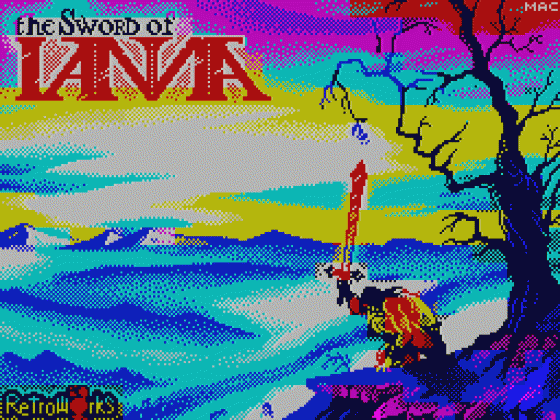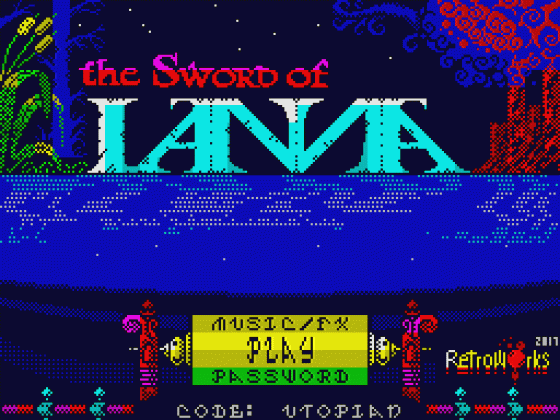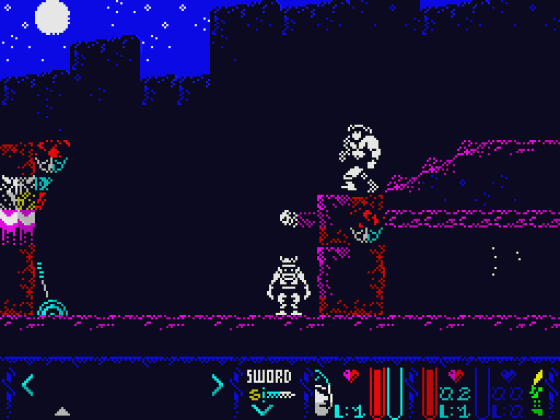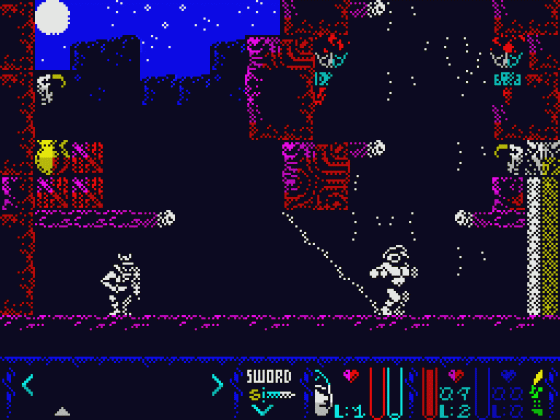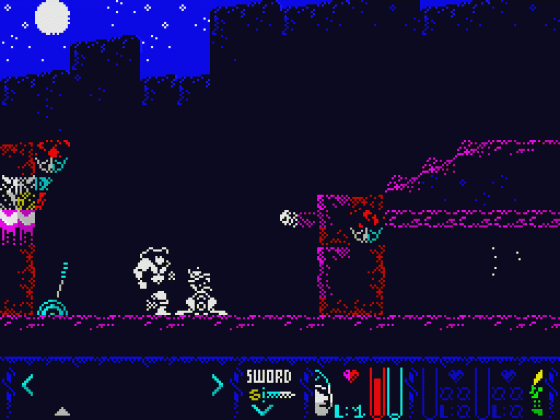
Everygamegoing
 31st December 2019
31st December 2019
Categories: Review: Software
Author: Dave E
Publisher: RetroWorks
Machine: Spectrum 128K
Hail To The King
I'm about one year late to the party that is The Sword Of Ianna. Originally this Spectrum 128K platform game was released on October 4th 2017 and received one of the most rapturous welcomes in living Speccy memory. It's a tale of a barbarian by the name of Jarkum, who inhabits the usual bleak landscape desolated by the ravages of a dark lord. The sword of the title isn't an artefact to be reclaimed to vanquish the lord, though; instead it begins the game securely sheathed to your belt. A quick tap of the Shift key will take it out and put it away again.
I have to admit that, having seen the hype surrounding this game on many of the Spectrum forums, I initially struggled to see what, exactly, all the fuss was about. We've seen this type of game several hundred times before in the guise of everything from Karnov through Strider to Shadow Of The Beast. Indeed, Retroworks, who are the force behind Sword Of Ianna, released a superficially very similar game called Vade Retro a mere three years previously. I only gave Vade Retro an overall rating of 51% too - the tired old formula of lone warrior ploughing through flick-screen after flick-screen of puzzles hacking through skeletal henchmen was more meh than mesmerising.
First Impressions
So why is The Sword Of Ianna almost universally considered one of the best Spectrum games of all time (Well, if Facebook is to be believed!), and certainly the best of 2017? I suspect the answer can be summed up in two words. Hidden depths. The clues that this game is really something special are there as soon as it thunders into life. A startlingly atmospheric intro and rich music welcome you in, for example. In days gone by, a good intro on the Spectrum used to signal the arrival of a good game. More recently though, some incredible openers have been tacked onto dross, making this old rule of thumb an unreliable indicator. Hence, despite all the hype, and all the attempts to build tension, my first impression was one of disappointment.

You can walk left and right, jump and sheath and unsheathe your sword. There are two health meters - one for energy, replenished by eating the food you find scattered around the environment and a second for, well, um, strength I suppose, as it seems to increase each time you successfully hack a bad guy into a dismembered mess. Curiously, you hold down the Space bar in combination with a direction key to run, you can do long jumps by running and jumping in combination and getting the sword out makes you more nimble of foot, stops you from running at all but instead allows you, in combination with up, down, left and right, to perform a repertoire of fighting moves. This makes for a game that handles probably quite differently from any other game of this type that you've played before. Nevertheless, it quickly becomes intuitive.
Looking Good
The animation of Jarkum is quite incredible. He hauls himself up cliff faces, swings from ledges, ducks, thrusts, uses his arms to propel his leaps through the air and even steps down from one foothold to another with incredible precision. Likewise the lord's henchmen, who inhabit every fourth screen, have incredibly realistic movement plus varied and quite manic attack patterns.
Despite the Spectrum's tendency to produce odd colour effects when one colour straddles another, there are no problems whatsoever in this regard. This is ever the more incredible when one considers that the backgrounds are themselves colourful and intricate. There's clearly some very sophisticated programming going on here.
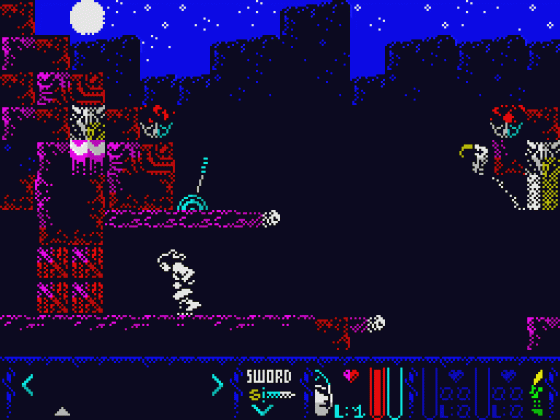
At its heart, the game's premise is quite a simple one. Avoid an untimely death, and solve the puzzles to make progress. Death, when it comes, is astonishingly brutal. One jab from an enemy's sword will put you in mortal danger; a second will finish you off. You also need to be careful when dropping through screens. Make use of any cliff-edges that you can, by hanging from them before letting go. Taking leaps of faith off the edges of them instead will often see you puree'd across the same terra firma. Thankfully, when you die, you return to a checkpoint rather than having to start the whole thing all over again.
Hidden Depths
As for the puzzles themselves, well, in these you discover those hidden depths I referred to. You'll find some objects hiding inside others - i.e. potions inside vases - and levers which open doors, or even sequences of doors. Making for some truly interesting play is the freedom the game allows you in the manipulation of these. You can use them to crush your enemies, for example. In addition, the game is multi-load and, as each new area moves in, there are subtle new variations of puzzle, including an area beset by rolling Indiana Jones-style orbs and of course the Big Boss Fight at the end. There are lots of other surprises too, but I'll leave the others for you to discover.
The scope of the game is huge. Playing it through will likely take you at least three hours, even once you know exactly where to go. And this is where I found a fairly familiar subject to criticize. This type of game really needs a little bit more instruction than "go to the fortress of Kashgar, find the monoliths and listen to the voice of your ancestors". It's a little tragic that Retroworks has worked so hard on this epic, only to release it with only the most cursory of game instructions. Some might argue that leaving the objective vague allows the player to fill in the detail himself but personally I like to see at least a list of game controls. It look me a while to even realise I had a sword; the instructions do not actually even mention it. Similarly, whilst initial levels are of the flick-screen left when you reach extreme left and vice versa, later levels have doors which can be stepped into or out of. It would be nice to have at least some indication that these facilities and areas do actually exist in the manual. Otherwise the player seems to discover them out of little more than blind luck.
A tiny other irk is that the redefined character set used in the intro and on-screen text is sometimes hard to read.
Conclusion
The Sword Of Ianna is a really great game, if a tough one. It certainly does not surprise me that it has taken more than three years to write. It's nothing short of a tour de force for the Spectrum and it is astounding. And it's all due to those hidden depths that I've touched upon. My worry is, however, that many casual gamers will never discover them. That's because, on loading it up, it looks just the same as a thousand others. You have to persevere with it to really reap the rewards that are contained within. But this is one new Spectrum game that everybody should be playing and how Retroworks will ever top this is anyone's guess.


